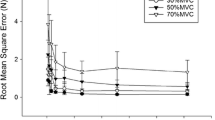Abstract
Force trajectories generated during human wrist flexing exertion was investigated under isometric conditions, and the corresponding EMG activity of forearm muscles was analyzed. An exertion of 50 N was developed by test subjects after a signal was sounded and a target level and force trajectory were either shown or not shown on a television screen. The force trajectories performed under conditions of visual control with presence of images (VC), under conditions of exertion "by memory" in the absence of target level images (KC, for kinesthetic control), and during random alteration of these two performance modes, (VC, KC)r, were compared. The latent periods for emergence of EMG flexion activity were shown to be approximately the same for VC and KC modes and noticeably longer for (VC, KC)r modes. As compared with VC mode performances, during KC mode performances the relative error for attainment of a given exertion and the duration of force trajectory late components were increased, while during (VC, KC)r mode performances the time interval between EMG emergence and initiation of force trajectory was increased; moreover, a significant correlational association between this interval and the time of an increase in the exertion rate was noted. Some hypotheses regarding formation of different force trajectory correction strategies for the different test conditions are proposed.
Similar content being viewed by others
Literature cited
A. A. Asknazii, "Physiological mechanisms for regulating pulse heights of voluntary human movements," Fiziol. Zh. SSSR,54, No. 2, 211–217 (1970).
N. A. Bernshtein, Synthesis of Movement [in Russian], Medgiz, Moscow (1947).
N. A. Bernshtein, Synopsis of Movement and Activity Physiology [in Russian], Meditsina, Moscow (1966).
N. I. Burlachkova, N. Z. Gurskaya, I. B. Kozlovskaya, and E. D. Markova, "Characteristics of programmed movements during arousal of various systems of the human cerebellum," Neirofiziologiya,18, No. 2, 233–241 (1986).
N. I. Burlachdova, N. Z. Gurskayam, I. B. Kozlovskaya, and E. D. Markova, "Destruction of accurate tracking movements during arousal of human cerebellum and pyramidal system," Neirofiziologiya,19, No. 3, 291–299 (1987).
G. F. Lakin, Biometry [in Russian], Vysshaya Shkola, Moscow (1980).
W. G. Darling and J. W. Cooke, "Movement-related DMG's become more variable during learning of fast accurate movement," J. Motor Behav.,19, No. 3, 311–331 (1987).
C. Chez and J. Gordon, "Trajectory control in targeted force impulses. I. Role of opposing muscles," Exp. Brain Res.,67, No. 2, 225–240 (1987).
J. Gordon and C. Chez, "Trajectory control intargeted force impulses. II. Pulse height control," Exp. Brain Res.,67, No. 2, 241–252 (1987).
J. Gordon and C. Chez, "Trajectory control in targeted force impulses. III. Compensatory adjustments for initial errors," Exp. Brain Res.,67, No. 2, 253–269 (1987).
J. R. Higgins and R. W. Angel, "Correction of tracking errors without sensory feedback," J. Exp Psychol.,84, No. 2, 412–416 (1970).
R. J. Jaeger, G. L. Gottlieb, and G. C. Agarwal, "Myoelectric responses at flexors and extensors of human wrist to step torque perturbations," J. Neurophysiol.,48, No. 2, 388–402 (1982).
R. J. Jaeger, G. L. Gottlieb, and G. C. Agarwal, "Afferent contributions to stretch-evoked myoelectric responses," J. Neurophysiol.,48, No. 2, 403–418 (1982).
N.-M Meinck, R. Benecke, W. Meyer, et al., "Human ballistic finger flexion: incoupling of the three-burst pattern," Exp. Brain Res.,55, No. 1, 127–133 (1984).
B. E. Mustard and R. G. Lee, "Relationship between EMG patterns and kinematic properties for flexion movements at the human wrist," Exp Brain Res.,66, No. 2, 247–256 (1987).
R. B. Stain, W. J. Cody, and C. Capaday, "The trajectory of human movements," J. Neurophysiol.,59, No. 6, 1814–1830 (1988).
Additional information
A. A. Bogomolets Institute of Physiology, Academy of Sciences of the USSR, Kiev. Translated from Neirofiziologiya, Vol. 23, No. 1, pp. 25–34, January–February, 1991.
Rights and permissions
About this article
Cite this article
Pyatigorskii, B.Y., Ivanov, A.É. Isometric exertion by the human wrist: Force trajectories with and without visual target. Neurophysiology 23, 20–28 (1991). https://doi.org/10.1007/BF01052285
Received:
Issue Date:
DOI: https://doi.org/10.1007/BF01052285




